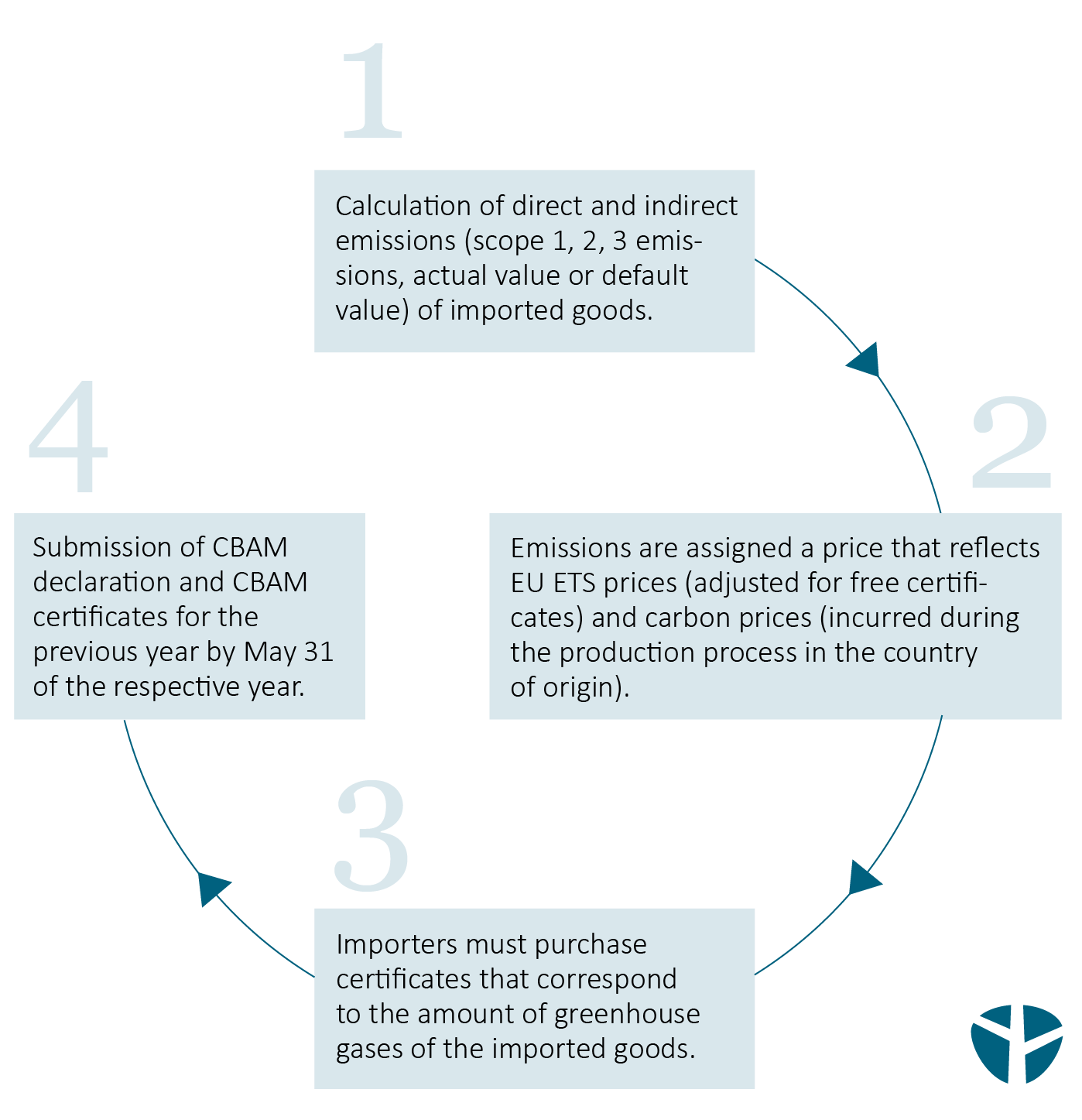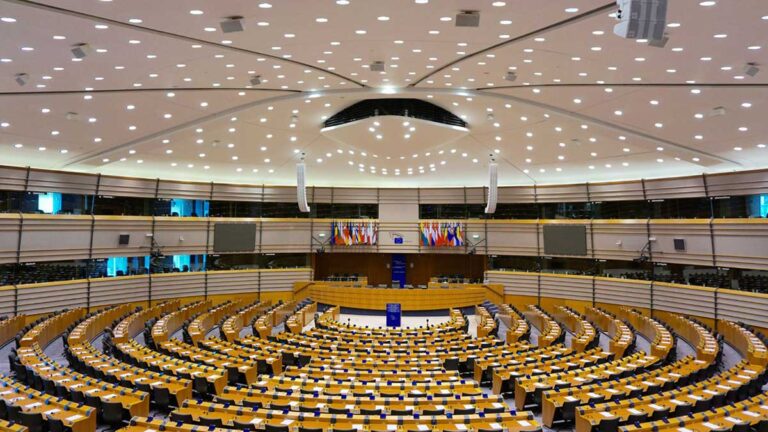By Nikolas Sachs and Alexander Saxenhuber
CBAM, Carbon Border Adjustment Mechanism, is an important climate protection instrument of the European Union (EU). CBAM affects broad segments of European industry but extends its reach far beyond EU borders. The first mandatory reporting period for affected companies has already started as of October 1st, 2023.
Currently, many questions are circulating among companies regarding CBAM: How does it work? What is CBAM and its aim for the EU? When does CBAM start and which goods are affected by the CBAM EU regulation? In this article, you will find all the important facts about the central EU pillar for decarbonization and how the CBAM supports the economy’s transformation on a net zero pathway.
What is the CBAM explained in a nutshell?
The CBAM prevents these evasive tendencies. This is because when so-called CBAM products are imported into the EU, a carbon price equivalent to the one inside the EU will have to be paid. Companies must then purchase so-called CBAM certificates in the amount of the calculated carbon tax. This shows how CBAM works as an important mechanism in the EU package of measures to contribute to cost truth, the transformation of business models and ultimately less climate change. The associated CBAM regulation has already entered into force in its first phase.
Aim of the CBAM EU regulation
The CBAM EU regulation has the aim to contribute to the EU’s climate neutrality in 2050. Anthropogenic climate change, caused primarily by human activities such as the burning of fossil fuels, poses a major threat to the health of our ecosystems. Our planet’s climate is changing significantly, leading to rising temperatures, extreme weather fluctuations and ecosystem disruption. The EU recognizes the urgency and is therefore taking a leading role in global efforts to mitigate climate change.
The EU’s ambitious climate policy is based on the Paris Climate Agreement. The countries have committed to limiting global warming ideally to 1.5°C compared to pre-industrial levels. By setting stringent targets to reduce greenhouse gas emissions, investing in renewable energy and promoting innovation, the EU aims to lead the transition to a sustainable, low-emission future. The EU has taken a proactive and ambitious approach to mitigating climate change and adapting to its inevitable consequences. This includes a variety of measures. The CBAM implementing regulation is just one of them.
CBAM and ETS: How are the CBAM, Fit for 55, and voluntary carbon credits related?
In July 2021, the European Commission presented the Fit for 55 package as part of the European Green Deal. One of the main objectives is to reduce greenhouse gas emissions by at least 55% until 2030 by modernizing existing legislation in line with the EU’s climate change targets. The Fit for 55 package aims to bring about the necessary changes to achieve climate neutrality in the EU by 2050.
An important component of the Fit for 55 package is the revision of the current emissions trading system (EU ETS). The EU ETS is to be expanded to include new sectors, the total quantity of emission allowances is to be reduced and the allocation of free emission allowances is to be phased out. This is intended to support the decarbonization of the economy through adequate and market-steered carbon prices. However, rising prices increase the risk of production facilities relocating to non-EU countries (carbon leakage). As CBAM should prevent carbon leakage, the CBAM regulation can be seen as an important complement to existing EU measures on climate neutrality.
Scope of CBAM: Which products are affected?
CBAM applies to various products that are particularly carbon-intensive to manufacture. Affected CBAM downstream and finished products fall under the following product categories:
- Cement
- Electricity
- Fertilizers (including intermediate products)
- Iron and steel (different processing stages)
- Aluminum (different processing stages)
- Hydrogen
CBAM will initially apply to imports of certain goods and intermediate products in these six sectors. However, by 2030, the CBAM is to be extended to all goods subject to the EU ETS. Further details on the goods can be found in the Official Journal of the European Union.
The method behind CBAM: How to calculate the new carbon price?
The CBAM methodology is based on the number of CBAM certificates that must be purchased when importing CBAM products from third countries. One certificate corresponds to one ton of greenhouse gas emissions. The quantity of CBAM certificates required is based on the Product Carbon Footprint (PCF) of the product being imported. The price per CBAM certificate is based on the average weekly price for EU emission allowances (EU ETS). Multiplied by each other, the CBAM calculation results in the total price.
CBAM implementing schedule
Importers only have to comply with CBAM reporting requirements - without financial obligations.
From then on, only an approved CBAM declarant can import the products concerned. Importers will also incur financial obligations that will gradually increase.
The EU's goal is to extend CBAM to all goods subject to the EU ETS by 2030.
Beginning in 2034, the CBAM is expected to be a full-cost burden.
Transition phase: CBAM reporting requirements (from 1st October 2023 to 31st December 2025)
Since October 1st, 2023, the CBAM transitional phase has been in effect. The purpose of the transition period is to collect information and refine methods in cooperation with importers, manufacturers and authorities. Importers are subject to a CBAM reporting requirement and must submit a CBAM quarterly report (for the first time at the end of January 2024) that must include the following information:
- the total quantity of each type of imported product by CBAM KN code, expressed in MWh (electricity) and in tons for other goods;
- total direct and indirect emissions (scope-1-2-3) of the imported product in t CO2 eq emissions per MWh of electricity or, in the case of other goods, in t CO2 eq emissions per ton for other goods;
- the carbon price to be paid in the country of origin for the emissions of the imported goods, taking into account any rebates or other compensatory measures.
This means that importers must know the “Product Carbon Footprint” (PCF) of the specific products they are importing. This PCF or emission factor of the product shall be calculated based on the official EU guidance or internationally recognized standards such as the Greenhouse Gas Protocol or applicable ISO norms. Environmental Product Declaration (EPD) or Life Cycle Assessment (LCA) for the imported products are other ways of getting the PCF information.
During the CBAM transition period, importers are not subject to any financial obligations. The CBAM quarterly report must be submitted to the CBAM transitional registry from October 1st, 2023, to December 31, 2025, no later than one month after the end of each quarter. Beginning December 31, 2024, importers may apply for status as an approved CBAM declarant. Once approved, the CBAM declarant will have access to their account in the CBAM transitional registry.
CBAM EU implementation: Start of financial CBAM obligations (from 1st January 2026)
As of January 1st, 2026, the CBAM will be fully in place and only authorized CBAM declarants are allowed to import CBAM products. The customs authorities of the EU member states are now obliged to monitor the movement of goods and to reject the import of CBAM goods by non-registered declarants.
From now on, each member state may sell CBAM certificates to authorized declarants established in the territory of the member state through a common central platform (the EU CBAM Transitional Registry) established and managed by the Commission. The information on the purchased certificates will be transferred to the declarant’s account in the CBAM registry. The price of the certificates is calculated according to the average weekly price for EU ETS allowances and published by the European Commission.
Beginning with the obligation in 2026, authorized CBAM declarants must submit their CBAM declaration and certificates through the CBAM registry by May 31st of each year. That means for the first time in 2027. The declaration must include:
- the total quantity of each type of goods imported in the previous calendar year, expressed in MWh for electric power and in tons (t) for other goods;
- total embedded emissions (PCF) expressed in tCO2 eq emissions per MWh of electricity or, in the case of other goods, t CO2 eq emissions per ton of the respective type of goods;
- the total number of CBAM certificates to be surrendered after any reduction in the carbon price paid in the country of origin, adjusted for the number of free allowances;
- copies of reports issued by an accredited body

CBAM EU expansion until 2030
After the CBAM transitional period, the existing CBAM model will be extended to all EU ETS sectors and associated products by 2030. Thus, CBAM will also successively apply to the following sectors:
- Oil refining
- Upstream fuel combustion
- All metals
- Pulp and paper
- Glass and ceramics
- Acids and organic chemicals
- Aviation
- Marine
- Lime
CBAM penalties and fines
According to Article 16 of the Implementing Regulation (EU) 2023/1773, Member States may impose sanctions if:
- the applicant has not taken the necessary steps to comply with the obligation to submit a CBAM declaration;
- the CBAM declaration is incomplete or incorrect within the meaning of Article 13 and the notifying declarant has not taken the necessary steps to correct the CBAM declaration when the competent authority has initiated the correction procedure according to Article 14(4).
The penalty imposed currently ranges from EUR 10 to EUR 50 per ton of unreported emissions. However, the penalty increases depending on the European Consumer Price Index. Higher penalties are imposed if more than two incomplete or incorrect reports are submitted in succession or if the CBAM reporting obligation is not fulfilled for more than six months.
CBAM consultation: What we recommend to companies regarding the CBAM regulation
The scope of the CBAM regulation is not based on the size of the company but on the product categories of imported goods. So, the question is not: Who does CBAM apply to? It is much more important that you address on time whether your imported products cause high emissions and therefore fall into the CBAM product categories. If that is the case, you should raise your CBAM attention and get prepared. A large number of European companies will have to reckon with rising costs due to carbon prices and CBAM certificates. At the same time, new framework conditions are emerging with regard to international competition beyond EU borders.
Therefore, we recommend that you address the new risks and opportunities created by the CBAM legislation, in addition to fulfilling reporting requirements. Transparency is the first step in taking the right measures, which you should ideally already develop during the CBAM transition phase. Our experienced decarbonization and regulatory teams will be happy to assist you in this process and support you with comprehensive CBAM guidance.




